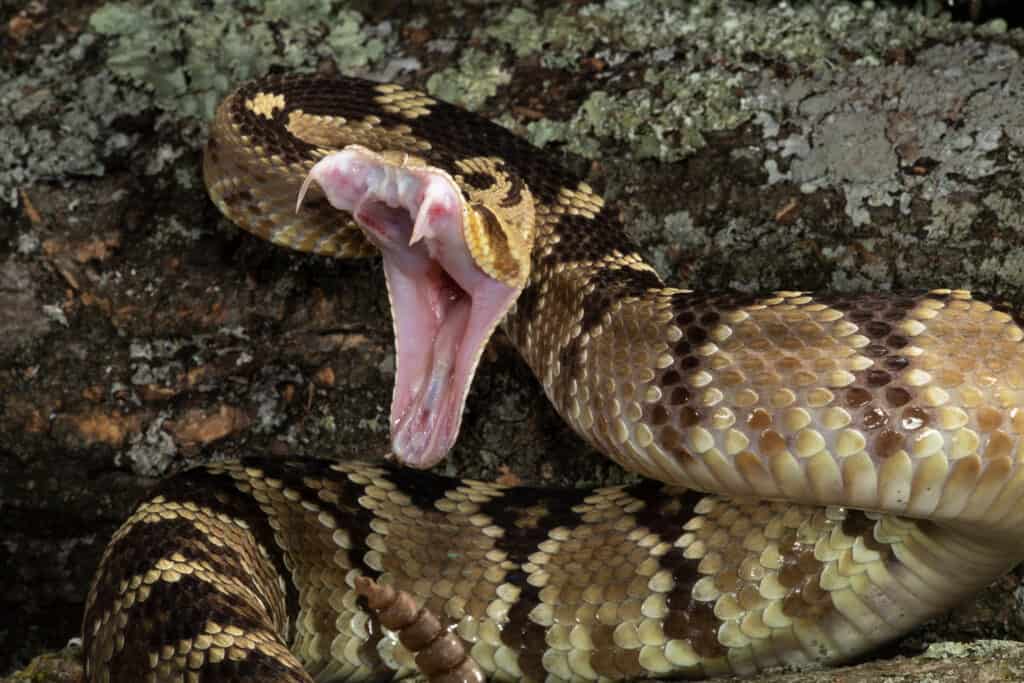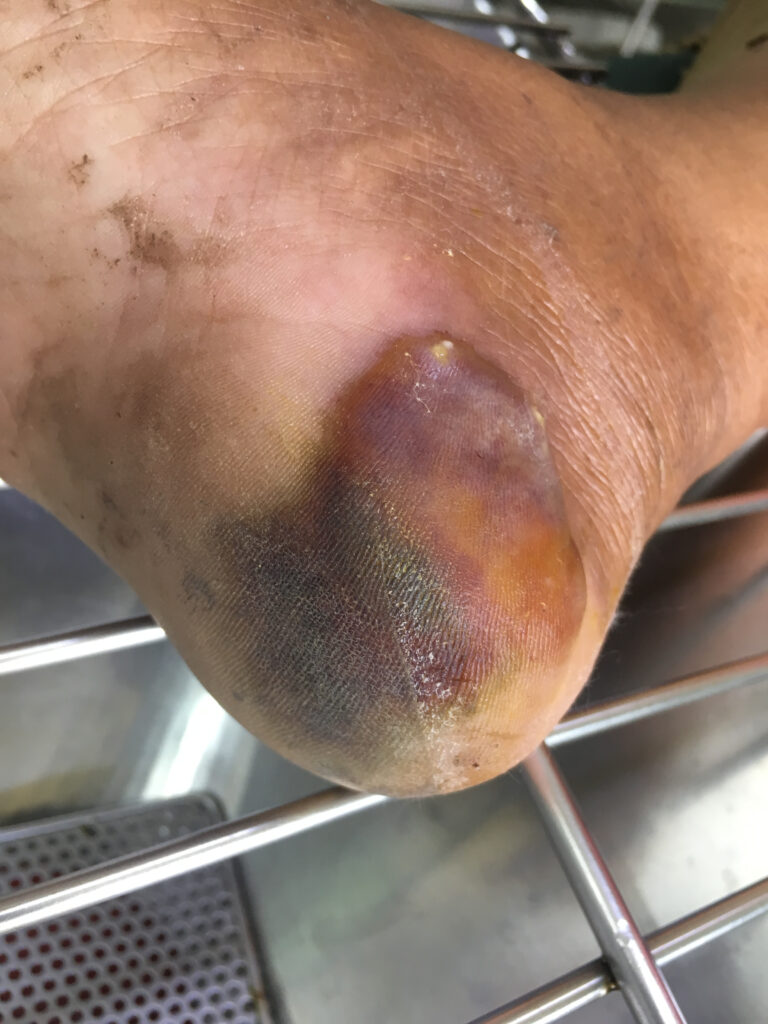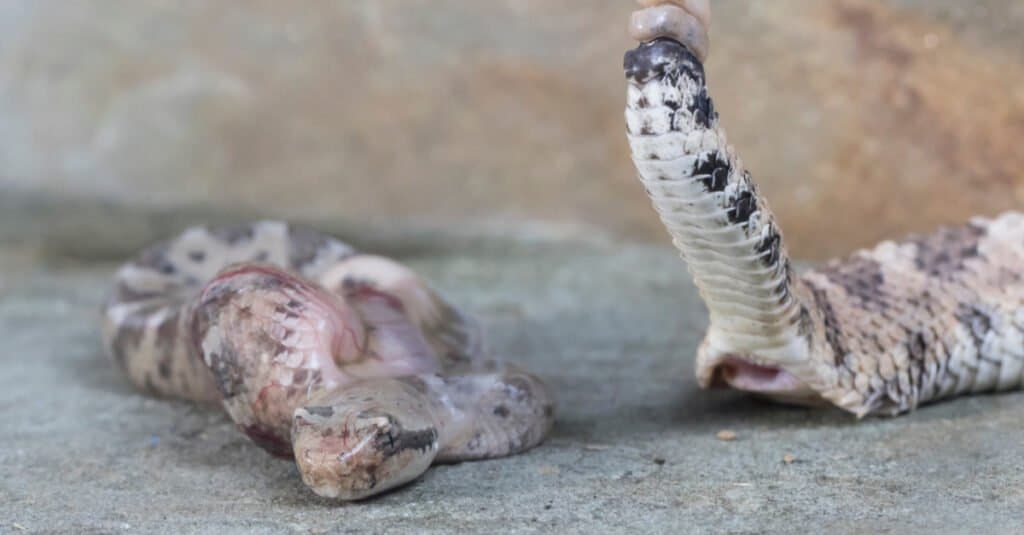Black-Tailed Rattlesnake
Crotalus molussus
One of the most beautiful rattlesnakes, they have solid black tails.
Advertisement
Black-Tailed Rattlesnake Scientific Classification
- Kingdom
- Animalia
- Phylum
- Chordata
- Class
- Reptilia
- Order
- Squamata
- Family
- Viperidae
- Genus
- Crotalus
- Scientific Name
- Crotalus molussus
Read our Complete Guide to Classification of Animals.
Black-Tailed Rattlesnake Conservation Status
Black-Tailed Rattlesnake Facts
- Prey
- Small mammals like rats, mice, and rabbits; also eats lizards and insects.
- Main Prey
- Small rodents
- Name Of Young
- Neonates; snakelets
- Group Behavior
- Largely solitary
- Communal Dens
- Fun Fact
- One of the most beautiful rattlesnakes, they have solid black tails.
- Biggest Threat
- Habitat loss
- Most Distinctive Feature
- Black tail and black snout
- Other Name(s)
- Mexican black-tailed rattlesnake, northern black-tailed rattlesnake, Oaxacan black-tailed rattlesnake, Mexican black-tailed rattlesnake
- Gestation Period
- About 90 days
- Litter Size
- 1-15
- Lifestyle
- Nocturnal/Crepuscular
- Favorite Food
- Small rats and mice
- Number Of Species
- 3
- Location
- Mexico, Arizona, New Mexico
Black-Tailed Rattlesnake Physical Characteristics
- Color
- Brown
- Yellow
- Black
- Tan
- Dark Brown
- Skin Type
- Scales
- Lifespan
- 15-20 yearas
- Venomous
- Yes
- Aggression
- Low
View all of the Black-Tailed Rattlesnake images!
The black-tailed rattlesnake is a venomous pit viper native to areas of Mexico and the southwestern United States. They’re one of the most easy-going rattlesnake species, but are still highly venomous and should not be handled unless absolutely necessary.
Let’s learn about these beautiful but dangerous snakes.
5 Black-Tailed Rattlesnake Amazing Facts
- There are three black-tailed rattlesnake subspecies.
- Female black-tailed rattlesnakes sometimes stay with their babies for up to a month after they’re born.
- Easily some of the most beautiful rattlesnakes, their blotch pattern and color contrast are beautiful.
- Mild mannered and shy, they’re more likely to slither away unless you corner one.
- Dorsal blotches are almost always separated by a couple of light-colored scales.
Black-Tailed Rattlesnake Scientific Name
Rattlesnakes are members of the Crotalinae subfamily of snakes. All pit vipers are in this subfamily and native to the Americas and parts of Asia and Indonesia. Their subfamily’s name comes from a Greek word, krotalon, which means rattle or castanet.
Black-tailed rattlesnakes’ scientific name is genus Crotalus molossus and, although their generic name is a form of the Greek krotalon, their specific name is Latin and refers to a large, fierce guard dog. These snake’s common name is from their tail’s color, because it’s always black.
Types of Black-Tailed Rattlesnakes
There are three currently accepted black-tailed rattlesnake subspecies.
- Northern black-tailed rattlesnake (Crotalus molossus molossus)
- Mexican black-tailed rattlesnake (Crotalus molossus nigrescens)
- Oaxacan black-tailed rattlesnake (Crotalus molossus oaxacus)
In addition, two other black-tailed rattlesnakes that aren’t subspecies anymore:
- Ornate black-tailed rattlesnake (Crotalus ornatus)
- Isla San Esteban rattlesnake (Crotalus estebanensis)
Rattlesnake Evolution & Origins
Scientists believe the rattles at the end of their tails evolved more recently. Although it could have been a response to the bison, no one knows. For example, the rattling behavior might have been a way to make some noise — protecting the snake from being stepped on.
Rattles are fascinating! There are no other snakes with that kind of tail hardware. Unfortunately, there’s no proof of how they developed, but scientists have a couple of theories.
One theory says that those snakes that could rattle their tails most vigorously and, for the longest, were more successful at deterring other threats. So, the rattle evolved as a better warning system.
Another theory suggests that the snakes that rattled the most developed keratin callouses on their tails. These crazy-rattling snakes might have developed genetic differences that made callouses evolve into rattles.
The Viperidae family probably developed between 56 and 48 million years ago during the early Eocene Era. However, pit vipers took another 25 to 45 million years to evolve. It took time to develop their specialized tails.
Venom has a different story.
This part of the arms race evolved in dozens of species at different times. Some species seem to have evolved and de-evolved venom multiple times. Scientists can only guess why. However, the need for venom probably disappeared for a while, then reemerged. Since most physical structures were already there, re-developing venom was relatively easy.
There are three main types of venom: neurotoxic, hemotoxic, and cytotoxic, which either incapacitate or kill the snakes’ prey. But, of course, if the snakes’ predators know about the venom’s danger, it’s a massive defensive advantage.
Most rattlesnakes possess hemotoxic venom. However, there’s sometimes a smaller cytotoxic or neurotoxic component — sometimes both!
According to research, Mojave rattlesnake venom is the most toxic of all rattlesnakes. However, that isn’t always true. Mojave rattlesnake venom is more dangerous because of a particular neurotoxin that some populations have, and others don’t.
Venom composition has both genetic and environmental components that scientists are working to understand.
Black-Tailed Rattlesnake Appearance and Description

Black-tailed rattlesnakes are venomous pit vipers native to Mexico, Arizona, and New Mexico.
©Joe McDonald/Shutterstock.com
The black-tailed rattlesnake is a medium-sized rattler ranging from 30 to 42 inches long; most individuals measure less than 39 inches. It has a big triangular head attached to a thin neck and, like other rattlesnakes, is heavy-bodied with a keratin rattle at the end. Black-tailed rattlesnakes are venomous and have hollow, hypodermic needle teeth that inject venom directly into their victim’s body.
Appropriately named, the black-tailed rattlesnake has solid black scales at the end of its tail. Most black-tailed rattlesnakes have a lot of dark pigment on their heads. Additionally, there’s usually a diagonal stripe from their eyes to the corner of their mouth, giving a mask effect.
Black-tailed rattlesnakes’ color varies, depending on their habitat and subspecies. They vary from yellows and olive greens to brown and black shades. Their markings narrow toward the belly and widen at the back and can be black, brown, green, yellow, and every shade in between. Some individuals’ markings may have lighter-colored centers. However, no matter what color the rest of the body is, the tail is always black.
One very noticeable difference between the black-tailed rattlesnake and the ornate black-tailed rattlesnake is that the ornate black-tailed rattlesnake has two large triangular scales right on the top of its snout.
You’ll also notice the spacing between their dorsal blotches and head pigmentation. In the black-tailed rattlesnakes, the dorsal blotches are almost always separated by a light-colored spot, and their head pigmentation can often cover most of their heads.
Black-Tailed Rattlesnake Behavior
Most black-tailed rattlesnakes are calm. Of course, there’s variation; some may be more reactive than others. However, these snakes aren’t typically as prone to the nervous reactivity you often see in western diamondback rattlesnakes.
This species is more likely to slither off if you encounter it unless it’s cornered. Black-tailed rattlesnakes will coil up, rattle, and strike if they feel threatened. However, they’re just not as likely to bite as other species. However, we don’t advocate picking up one of these snakes without proper training. They are dangerous wild animals and will bite if they feel threatened.
It’s primarily terrestrial but sometimes climbs into trees and bushes, possibly looking for shelter or prey. Black-tailed rattlesnakes are ambush predators. They use camouflage to their great advantage, often finding a secluded place to wait for their meal to wander close enough to grab.
Black-tailed rattlesnakes are diurnal during the spring and fall, then become nocturnal to avoid the summer heat. They brumate in rock crevices, caves, and animal burrows during the winter. They often share brumation sites with other snakes, including other species.
Black-Tailed Rattlesnake Habitat
Black-tailed rattlesnakes are versatile and inhabit areas with tropical shrubs, forests, mesquite grasslands, cactus, and thornbush in rocky areas like canyon slopes, outcrops, and the edges of stream courses. A population in Arizona frequents dry riverbeds and takes shelter in the scrub brush along the edges.
In the United States, black-tailed rattlesnakes inhabit Arizona, southwestern New Mexico, and central to western Mexico. Scientists previously counted populations in eastern New Mexico, Texas, and eastern Mexico as the same species. However, a 2012 revision moved them into their species as the eastern or ornate black-tailed rattlesnake (Crotalus ornatus).
Black-Tailed Rattlesnake Diet
Like other snakes, black-tailed rattlesnakes are crucial to keeping rodent populations from overrunning the world. These rodent-exterminating reptiles’ diet contains rats, mice, and small rabbits. They also eat birds, bird eggs, and lizards.
Venom: How Dangerous Is a Black-Tailed Rattlesnake?
Some estimates put their danger level about 80% of western diamondback rattlesnakes — in terms of venom. However, they’re still venomous snakes! Because they’re so calm, they don’t often rattle until you’re too close. A bite from a black-tailed rattlesnake with envenomation usually requires antivenom for successful treatment.
Researchers use pit viper venom in many applications. For example, venom from some snakes, like the golden lancehead, has been used in medical research, and a few life-saving drugs exist because of venom research.
Rattlesnake Bite Symptoms
If you are the unfortunate recipient of a venomous snakebite, here is what you can expect — if the snake envenomated you. The symptoms range from minor to severe depending on how much venom the snake used. Fortunately, up to 30 to 40% of all snakebites are dry — having no venom. However, if you’re one of the unlucky 7,000 to 8,000 people in the United States this year to be bitten, that dry bite sounds more like a myth than reality.

Most bites occur when humans accidentally step on or near a rattlesnake or attempt to handle or kill one.
©Chuanpit/Shutterstock.com
Symptoms of black-tailed rattlesnake venom
- Most bites are on the hands and feet — always keep them visible while hiking.
- Fang marks — these aren’t always present and they may look more like scratches.
- Pain, skin discoloration, swelling, and blistering of the skin around the bite location.
Severe envenomation may see even more symptoms:
- Thin blood oozing from the wound.
- Metallic taste or excessive salivation
- Chills and sweating
- Numbness or tingling sensation
- Nausea and vomiting
- Anxiety
- Difficulty breathing
- Abnormal heartbeat
- Other neurologic symptoms
First Aid
The first thing is stay calm and move away from the snake. If you panic, the venom gets carried around the body faster and will cause more damage. Unless it’s a severe envenomation, doctors will treat each of your symptoms as they arise. Antivenom has its own set of risks, one of which is anaphylaxis, so it’s not the first choice unless it’s necessary.
- DO head to the hospital.
- DO make note of the snake’s appearance (from a distance).
- DO keep the body part below the heart if possible.
- DO remove tight clothing and jewelry.
- DO try to immobilize the body part, if possible.
- DO NOT try to suck out the venom. It’s injected far too deeply for you do do anything helpful.
- DO NOT drink alcoholic or caffeinated drinks.
- DO NOT use a tourniquet.
Reproduction, Babies, and Lifespan

Rattlesnakes are born and don’t hatch from eggs that the mother lays.
©Mark_Kostich/Shutterstock.com
Black-tailed rattlesnakes can live 15-20 years, possibly longer in captivity. They mate when they come out of brumation in the spring. The males follow pheromone trails left by receptive females; after mating, they’ll often stay near the female for a few days to keep other males from being able to also mate.
Like other rattlesnakes, this species doesn’t lay eggs — the females carry the babies for about 90 days, until they’re ready ready to be born. Then, instead of taking off after they give birth, the moms have been observed staying with babies for nearly a month, protecting them until the first time they shed.
Population and Conservation Status
The IUCN Redlist of Threatened Species last assessed the black-tailed rattlesnake in 2007, before scientists reclassified the ornate black-tailed rattlesnake as a separate species. According to their assessment, they determined that its population was stable.
Thanks to the remote areas where most of these snakes live, there aren’t many human-snake encounters. Organizations like SavetheBuzztails.org help improve conservation and education efforts so people can learn about these important and misunderstood animals.
Similar Animals
- Western rattlesnake
- Prairie rattlesnake
- Western diamondback rattlesnake
- Ornate black-tailed rattlesnake
Black-Tailed Rattlesnake FAQs (Frequently Asked Questions)
How do black-tailed rattlesnakes hunt?
By ambush, of course! Black-tailed rattlesnakes are somewhat sedentary snakes and like to find a safe place to hang out while they wait for a meal. They camouflage in their habitat so well that they’re nearly invisible.
How venomous are black-tailed rattlesnakes?
Extremely, although not as dangerous as western diamondback rattlesnakes. Fortunately, antivenom is widely available.
Can western rattlesnakes envenomate when they're born?
Yes! They’re born with venom and are able to control it. What good is having a great hunting weapon without knowing how to use it?
Do black-tailed rattlesnakes have any predators?
For such a fearsome predator, you might be surprised to discover that pretty much everything that preys on or eats meat will go after a rattlesnake. The predator list includes hawks, owls, coyotes, kingsnakes, coachwhips, and several others.
Thank you for reading! Have some feedback for us? Contact the AZ Animals editorial team.
Sources
- Reptarium Reptile Database, Available here: https://reptile-database.reptarium.cz/species?genus=Crotalus&species=molossus
- Multifunctional Toxins in Snake Venoms and Therapeutic Implications: From Pain to Hemorrhage and Necrosis, Available here: https://www.frontiersin.org/articles/10.3389/fevo.2019.00218/full
- iNaturalist.org, Available here: https://www.inaturalist.org/taxa/515948-Crotalus-molossus
- Dovemed.com, Available here: https://www.dovemed.com/diseases-conditions/black-tailed-rattlesnake-bite/

















